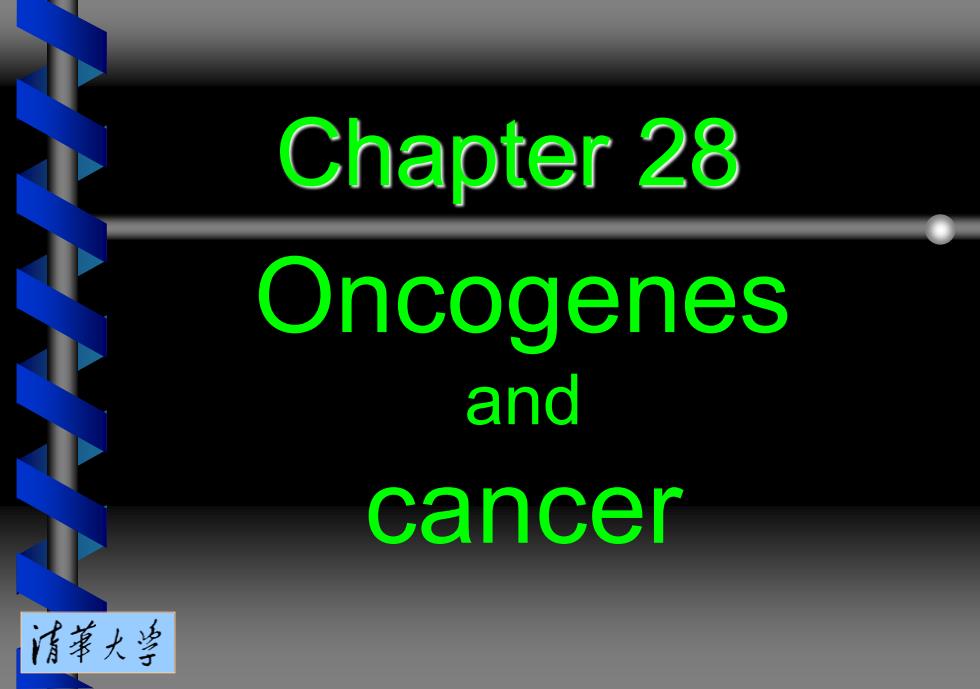
Chapter 28 Oncogenes and cancer 清第大当
Chapter 28 Oncogenes and cancer
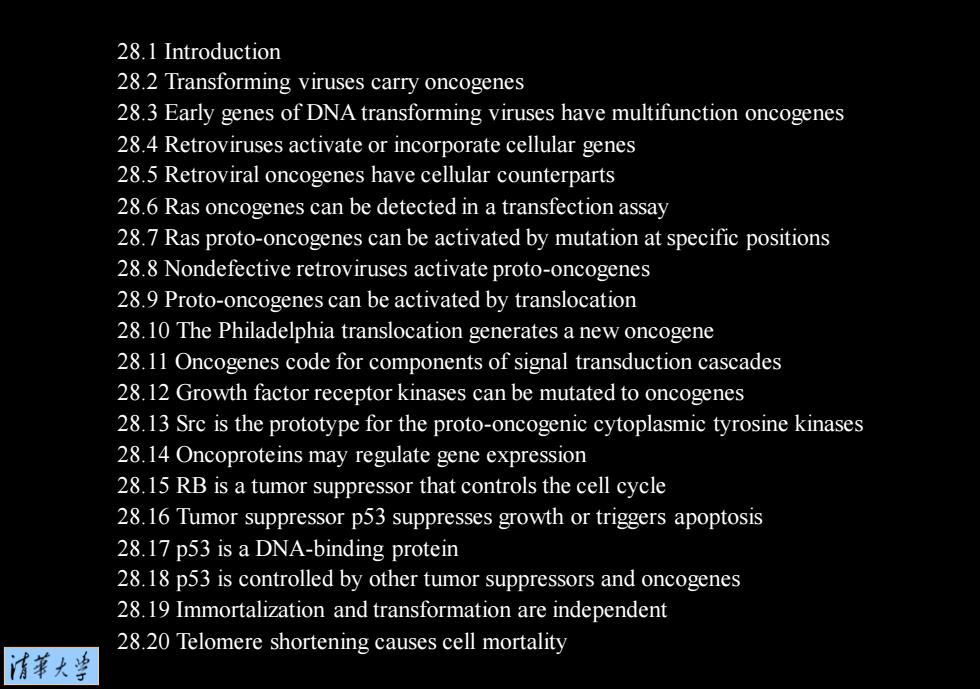
28.1 Introduction 28.2 Transforming viruses carry oncogenes 28.3 Early genes of DNA transforming viruses have multifunction oncogenes 28.4 Retroviruses activate or incorporate cellular genes 28.5 Retroviral oncogenes have cellular counterparts 28.6 Ras oncogenes can be detected in a transfection assay 28.7 Ras proto-oncogenes can be activated by mutation at specific positions 28.8 Nondefective retroviruses activate proto-oncogenes 28.9 Proto-oncogenes can be activated by translocation 28.10 The Philadelphia translocation generates a new oncogene 28.11 Oncogenes code for components of signal transduction cascades 28.12 Growth factor receptor kinases can be mutated to oncogenes 28.13 Sre is the prototype for the proto-oncogenic cytoplasmic tyrosine kinases 28.14 Oncoproteins may regulate gene expression 28.15 RB is a tumor suppressor that controls the cell cycle 28.16 Tumor suppressor p53 suppresses growth or triggers apoptosis 28.17 p53 is a DNA-binding protein 28.18 p53 is controlled by other tumor suppressors and oncogenes 28.19 Immortalization and transformation are independent 28.20 Telomere shortening causes cell mortality 清苇大兰
28.1 Introduction 28.2 Transforming viruses carry oncogenes 28.3 Early genes of DNA transforming viruses have multifunction oncogenes 28.4 Retroviruses activate or incorporate cellular genes 28.5 Retroviral oncogenes have cellular counterparts 28.6 Ras oncogenes can be detected in a transfection assay 28.7 Ras proto-oncogenes can be activated by mutation at specific positions 28.8 Nondefective retroviruses activate proto-oncogenes 28.9 Proto-oncogenes can be activated by translocation 28.10 The Philadelphia translocation generates a new oncogene 28.11 Oncogenes code for components of signal transduction cascades 28.12 Growth factor receptor kinases can be mutated to oncogenes 28.13 Src is the prototype for the proto-oncogenic cytoplasmic tyrosine kinases 28.14 Oncoproteins may regulate gene expression 28.15 RB is a tumor suppressor that controls the cell cycle 28.16 Tumor suppressor p53 suppresses growth or triggers apoptosis 28.17 p53 is a DNA-binding protein 28.18 p53 is controlled by other tumor suppressors and oncogenes 28.19 Immortalization and transformation are independent 28.20 Telomere shortening causes cell mortality
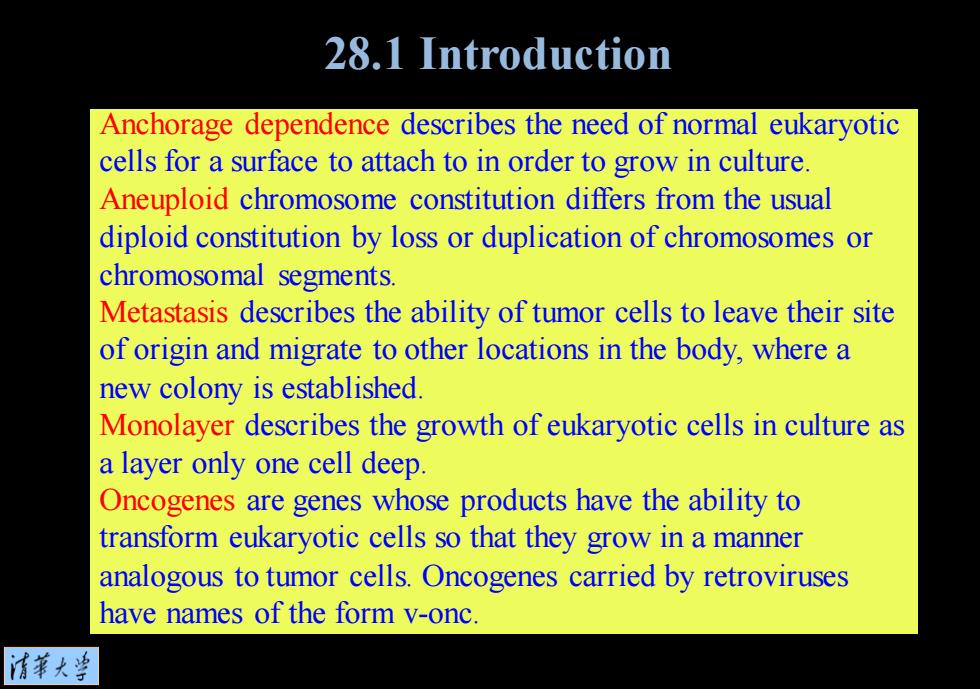
28.1 Introduction Anchorage dependence describes the need of normal eukaryotic cells for a surface to attach to in order to grow in culture Aneuploid chromosome constitution differs from the usual diploid constitution by loss or duplication of chromosomes or chromosomal segments. Metastasis describes the ability of tumor cells to leave their site of origin and migrate to other locations in the body,where a new colony is established. Monolayer describes the growth of eukaryotic cells in culture as a layer only one cell deep. Oncogenes are genes whose products have the ability to transform eukaryotic cells so that they grow in a manner analogous to tumor cells.Oncogenes carried by retroviruses have names of the form v-onc. 情華大当
Anchorage dependence describes the need of normal eukaryotic cells for a surface to attach to in order to grow in culture. Aneuploid chromosome constitution differs from the usual diploid constitution by loss or duplication of chromosomes or chromosomal segments. Metastasis describes the ability of tumor cells to leave their site of origin and migrate to other locations in the body, where a new colony is established. Monolayer describes the growth of eukaryotic cells in culture as a layer only one cell deep. Oncogenes are genes whose products have the ability to transform eukaryotic cells so that they grow in a manner analogous to tumor cells. Oncogenes carried by retroviruses have names of the form v-onc. 28.1 Introduction
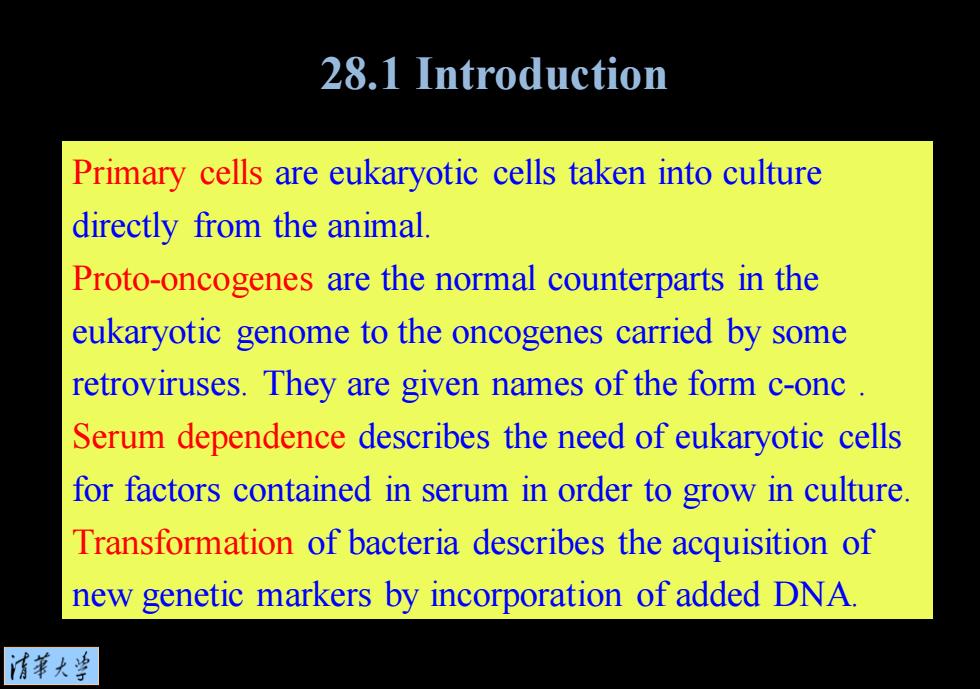
28.1 Introduction Primary cells are eukaryotic cells taken into culture directly from the animal. Proto-oncogenes are the normal counterparts in the eukaryotic genome to the oncogenes carried by some retroviruses.They are given names of the form c-onc. Serum dependence describes the need of eukaryotic cells for factors contained in serum in order to grow in culture. Transformation of bacteria describes the acquisition of new genetic markers by incorporation of added DNA. 清菜大当
Primary cells are eukaryotic cells taken into culture directly from the animal. Proto-oncogenes are the normal counterparts in the eukaryotic genome to the oncogenes carried by some retroviruses. They are given names of the form c-onc . Serum dependence describes the need of eukaryotic cells for factors contained in serum in order to grow in culture. Transformation of bacteria describes the acquisition of new genetic markers by incorporation of added DNA. 28.1 Introduction
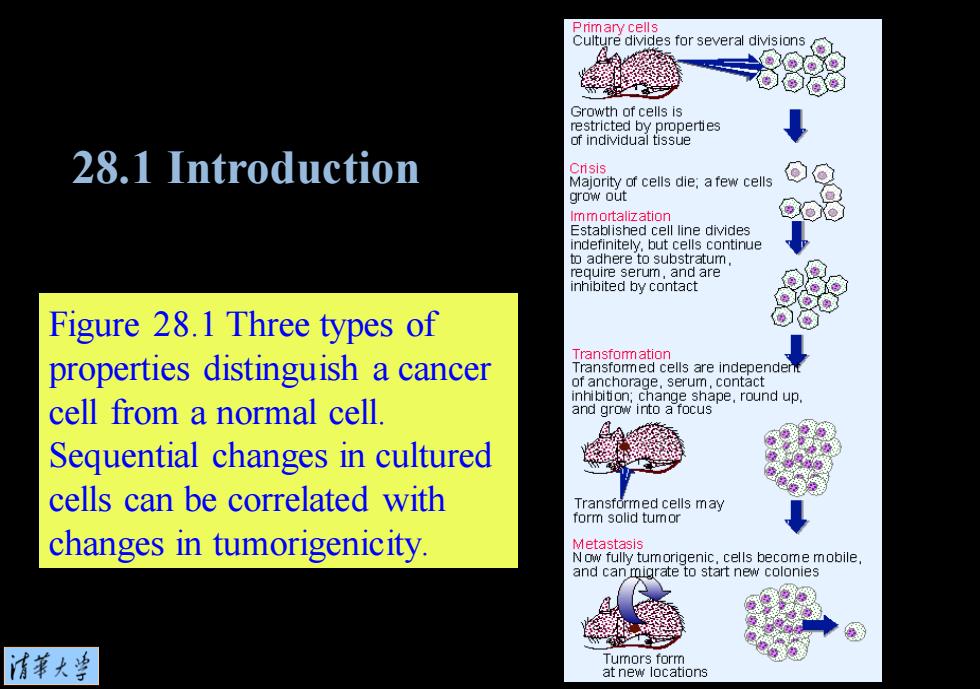
rimary cells Culture divides for several divisions @@60 Growth of cells is restricted by properties of individual tissue 28.1 Introduction Crisis Majority of cells die;a few cells grow out Immortalization Established cell line divides indefinitely,but cells continue to adhere to substratum. require serum,and are inhibited by contact Figure 28.1 Three types of 6S8 @⊙ properties distinguish a cancer Transfom ation Transfomed cells are independent of anchorage.serum,contact nhibiti on;change shape,round up. cell from a normal cell. and grow into a focus Sequential changes in cultured cells can be correlated with Transtormed cells may form solid tumor changes in tumorigenicity. Metastasis Now fully tumorigenic,cells become mobile and can migrate to start new colonies 情菜大学 Tumors form at new locations
Figure 28.1 Three types of properties distinguish a cancer cell from a normal cell. Sequential changes in cultured cells can be correlated with changes in tumorigenicity. 28.1 Introduction
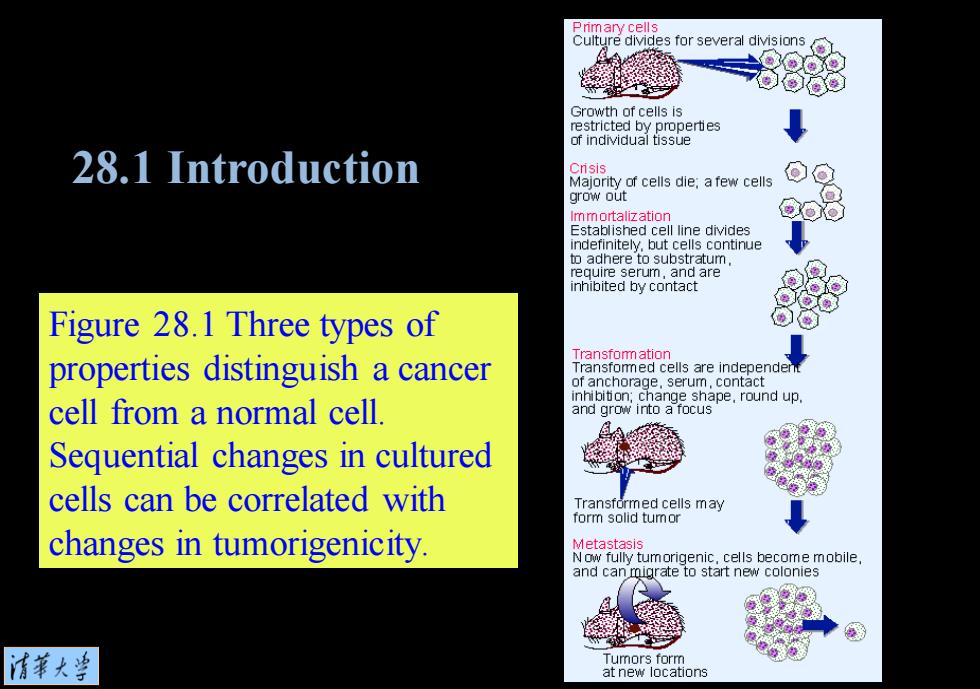
Primary cells Culture divides for several divisions Growth of cells is restricted by properties of individual tissue 28.1 Introduction Cnsis Majority of cells die;a few cells grow out Immortalization Established cell line divides indefinitely,but cells continue to adhere to substratum require serum,and are inhibited by contact Figure 28.1 Three types of properties distinguish a cancer Transfom ation Transfomed cells are independent of anchorage.serum.contact nhibiti on;change shape,round up cell from a normal cell and grow into a focus Sequential changes in cultured cells can be correlated with Transformed cells may form solid tumor changes in tumorigenicity. Metastasis Now fully tumorigenic,cells become mobile, and can migrate to start new colonies 清苇大当 Tumors form at new locations
Figure 28.1 Three types of properties distinguish a cancer cell from a normal cell. Sequential changes in cultured cells can be correlated with changes in tumorigenicity. 28.1 Introduction
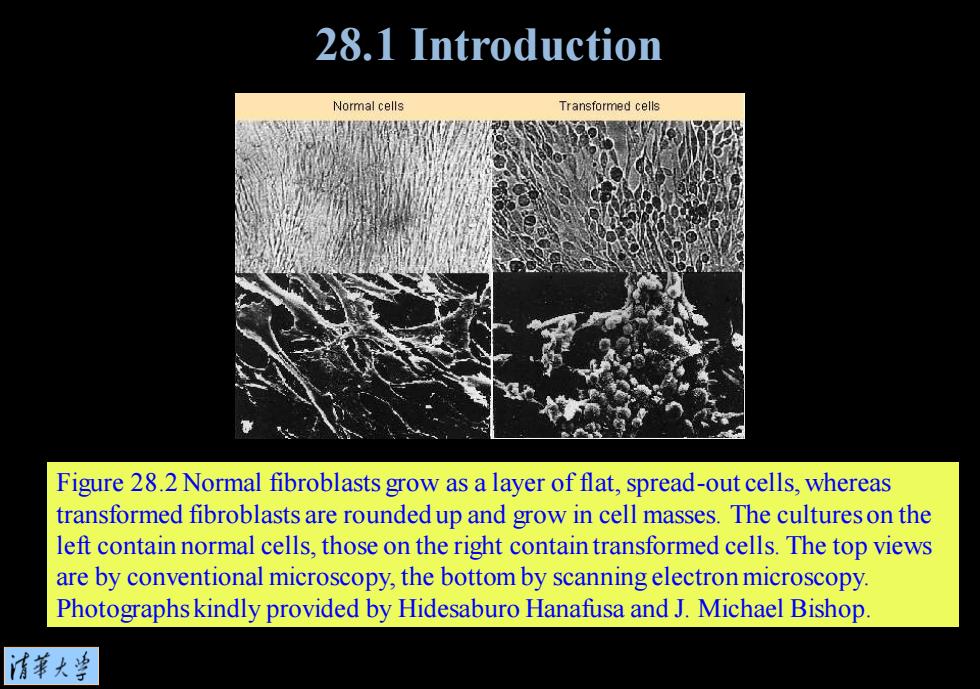
28.1 Introduction Normal cells Transformed cells Figure 28.2 Normal fibroblasts grow as a layer of flat,spread-out cells,whereas transformed fibroblasts are rounded up and grow in cell masses.The cultures on the left contain normal cells,those on the right contain transformed cells.The top views are by conventional microscopy,the bottom by scanning electron microscopy. Photographskindly provided by Hidesaburo Hanafusa and J.Michael Bishop. 情菜大当
Figure 28.2 Normal fibroblasts grow as a layer of flat, spread-out cells, whereas transformed fibroblasts are rounded up and grow in cell masses. The cultures on the left contain normal cells, those on the right contain transformed cells. The top views are by conventional microscopy, the bottom by scanning electron microscopy. Photographs kindly provided by Hidesaburo Hanafusa and J. Michael Bishop. 28.1 Introduction

28.2 Transforming viruses carry oncogenes Viral Class Genome Genome Size Oncogenes Origin of Oncogene Action of Onoogene Polyoma dsDNA 5-6kh T antigens Early viral gene inadivates tumor suppressor HPV dsDNA ~8kb E6&E7 Early viral gene inadivates tumor suppressor Adeno dsDNA ~37 kb E1A E1B Early viral gene inadivates tumor suppressor Retrovirus SSRNA 6-9kh Individual Cellular adivates oncogenic pathay (acute) Figure 28.3 Transforming viruses may carry oncogenes. 清菜大当
Figure 28.3 Transforming viruses may carry oncogenes. 28.2 Transforming viruses carry oncogenes
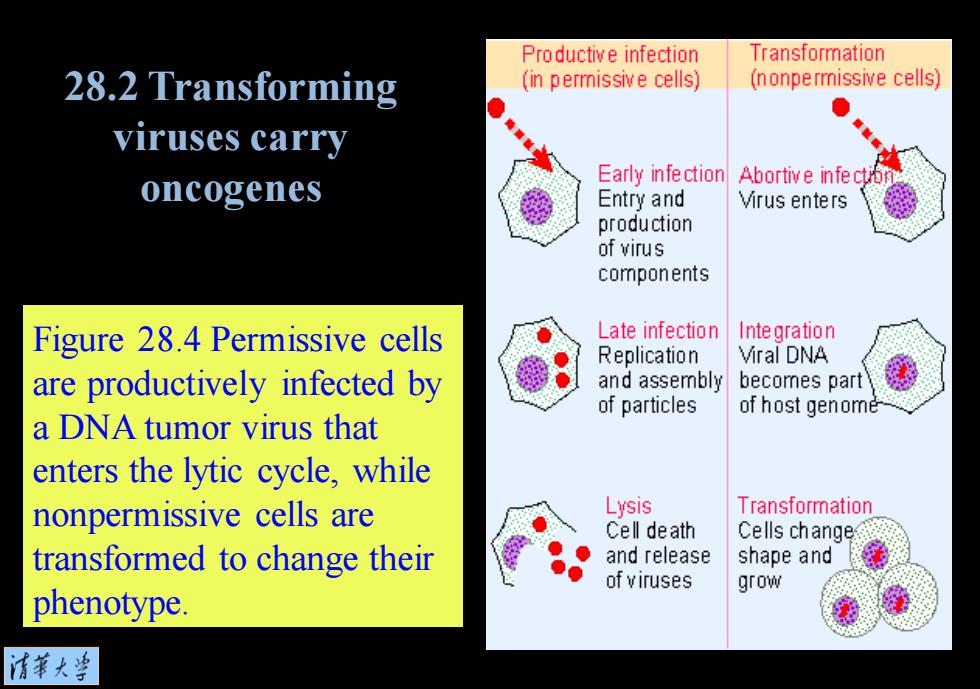
Productive infection Transformation 28.2 Transforming (in permissive cells) (nonpermissive cells) viruses carry Early infection Abortive infe ct oncogenes Entry and Virus enters production of virus components Figure 28.4 Permissive cells Late infection Integration Replication Viral DNA are productively infected by and assembly becomes part of particles of host genome a DNA tumor virus that enters the lytic cycle,while nonpermissive cells are Lysis Transformation Cell death Cells change transformed to change their and release shape and of viruses grow phenotype. 情菜大当
Figure 28.4 Permissive cells are productively infected by a DNA tumor virus that enters the lytic cycle, while nonpermissive cells are transformed to change their phenotype. 28.2 Transforming viruses carry oncogenes

28.2 Transforming late viruses carry SV40 oncogenes 价ANN Infection Adenovirus early late Figure 28.5 Cells 入10707020八N风M八N transformed by ↓ polyomaviruses or HOSt DNAROCOUU入入NN adenoviruses have viral Integratig sequences that include the N入八N入八NNNN入N early region integrated into the cellular genome.Sites of Transforming ogog integration are random. (onco-)protein SV40 T/t antigens Adenovirus E1A,E1B 清第大兰
Figure 28.5 Cells transformed by polyomaviruses or adenoviruses have viral sequences that include the early region integrated into the cellular genome. Sites of integration are random. 28.2 Transforming viruses carry oncogenes